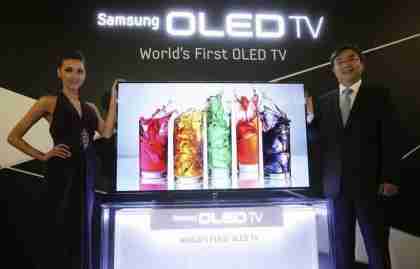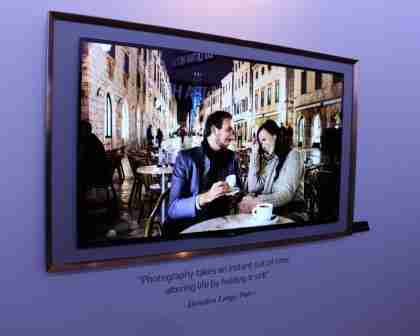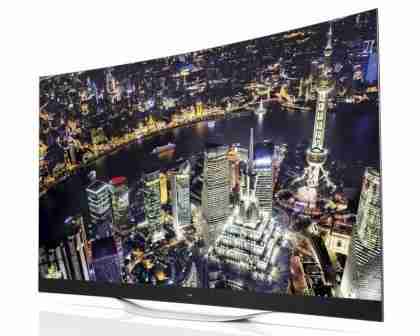It's taken a long time, but OLED televisions are finally starting to arrive in UK shops. The technology has been lauded as the future of TV for years, but high prices, complex production processes and lifespan concerns have repeatedly held it back from the high street. It's a pattern that's beginning to change, but with existing LCD and plasma technology so heavily entrenched it's going to be an uphill battle.
In order to understand what impact OLED will have on TVs in the very near future, we've broken down the technology to see what all the fuss is about.

OLED TV has been the big next thing for quite some time, but we're finally getting there
ORGANIC LIGHTING
In the simplest terms, Organic Light Emitting Diodes (OLEDs) sandwich an organic semiconductor between two electrodes, an anode and a cathode, which emit light as an electric current is passed between them. Each one is around 100 to 500 nanometres thick, or roughly 200 times thinner than a human hair.
The semiconductor is comprised of two layers; an emissive layer and a conductive layer. Both are made from organic material, which release energy as light when electrons move from one to the other. The anode removes the electrons from the conductive layer as a current flows through it, leaving holes that need to be filled with electrons in the emissive layer. The cathode injects electrons into the emissive layer, and as the holes jump between layers and recombine with the electrons light is created. The brightness intensity depends on the amount of current applied. The colour of the light depends on the type of organic material within the emissive layer, which we'll discuss more below.

OLED TVs produce plasma-like blacks, very dark with lots of contrast in the image
OLEDs aren't rigid by themselves, needing to be attached to a substrate before they can be used in a display. This can be made from glass, clear plastic or foil, depending on what the screen will be used for. If the substrate is opaque or reflective, it is known as a top-emitting structure, letting light exit in just one direction. This is the kind most commonly used for TVs, smartphones and other traditional displays. Conversely, transparent structures use a transparent substrate to let light out in both directions. These are mostly used for Heads-up Displays (HUDs).
THERE CAN BE ONLY ONE
There are currently two competing OLED formats, produced by Korean companies Samsung and LG, with each having its own way of generating colour images.
Samsung uses RGB OLEDs, with each pixel comprised of red, green and blue sub-pixels. The blue sub-pixels are around 1.5x larger than the others because they are less efficient, and are run at a lower brightness to compensate for the fact that they age faster than the other two sub-pixels. Production costs are typically higher than competing OLED designs due to the size of the laser used to produce the substrate, which is made from a Low Temperature Polycrystalline Silicon (LTPS) TFT.
LG meanwhile, has opted for WOLED technology, which uses a mixture of organic materials to create an OLED that emits essentially a white light. The light then passes through a colour refiner that extracts the red, green and blue elements of the light. In addition the fourth sub-pixel is a pure white pixel, which is used to help balance the colour output. These are all fitted to an oxidized TFT substrate.

You can get a rough idea of the differences in this diagram
ADVANTAGE OLED
Regardless of the type of technology used, there are good reasons as to why OLED is being presented as the "future of TV" – on paper it's the ideal middle ground between the existing plasma and LCD tech currently powering our TVs.
The main advantage is that OLED displays do not require a backlight. LCD displays use backlights to illuminates the entire screen, often leading to washed out greys instead of deep blacks. Even more expensive LCD models, which use local dimming to split the backlight into different zones and limit the amount of bleed when displaying dark images, can't create perfect blacks - "halo" effects around bright objects are common if the backlight zones aren't small enough.
Plasma panels might be able to produce incredibly deep blacks, but they use an awful lot of power to do so. OLED displays are significantly more energy efficient, even more so than LCD screens. Plasma panels can't be economically produced in sizes smaller than 32in either, meaning the technology isn't suitable for smartphones or laptops.
Because OLEDs create light, rather than block it like LCDs, they have far superior viewing angles. There's no visible colour shift, even when sat at almost 90 degrees to normal. They also have near-instantaneous response times - up to one hundred times faster than a typical LCD panel. OLED panels are thinner, lighter and more flexible than both LCD and plasma displays. Because the substrates are made from plastic rather than glass, they can be bent into shapes as well as laid flat, allowing for curved TVs like Samsung's S9C. Glass also absorbs a small amount of light, but because plastic doesn't OLEDs are brighter than LEDs too.
Finally, OLEDs will eventually be easier to produce. As they are essentially plastics, OLEDs can be made into large, thin sheets that are then cut to size for specific screens. Once manufacturing processes are streamlined, OLEDs will almost certainly drop in price.
RICH MAN'S TOY?
Based on what we've seen from the few production OLED TVs out there, we're fairly convinced that the technology will eventually become the standard for new TVs. However, until they drop significantly in price, that is unlikely to be any time soon. The reason for such high prices is that manufacturing costs are much higher than either LCD or plasma. The number of usable panels from any given production run, otherwise known as a yield, is incredibly low. According to research by the NPD Display Group , manufacturing costs could drop as much as 36% in 2014 compared to this year, but that will still mean paying almost five times the amount of money for an OLED TV compared to an LCD set.
Currently you can only buy curved OLED sets from Samsung and LG here in the UK. When asked why there's no standard OLED TV on sale yet, LG says "The curved screen looks wider and delivers a more realistic experience free of image distortion, regardless of where you look". Samsung, meanwhile, says that "Our new 55” OLED TV is curved because we wanted to offer a very special experience. It also helps distinguish the OLED technology from other TVs at retail".

Curved screens seem to be the key marketing differentiator for OLED TVs, but we're not convinced the shape is anything more than a gimmick
Reading between the lines, these statements are basically confirming that OLED is in such limited supply right now that the only way either company could launch a TV was to make a design statement that will turn heads, but not open wallets. It means a lot more waiting until it becomes the standard for new TVs, but with both companies working hard on improving the technology, we will hopefully see affordable sets in the next three years. If that's not soon enough, be prepared to pay a pretty penny today for what is basically future technology.
It's taken a long time, but OLED televisions are finally starting to arrive in UK shops. The technology has been lauded as the future of TV for years, but high prices, complex production processes and lifespan concerns have repeatedly held it back from the high street. It's a pattern that's beginning to change, but with the existing LCD technology so heavily entrenched it's going to be an uphill battle.
Read about our first preview of a Samsung OLED TV in the UK - Samsung S9C 55in OLED TV review - First Look
